This was published 5 years ago
'We'll be bathing in salt water': At the epicentre of Australia's big drought
By Peter Hannam
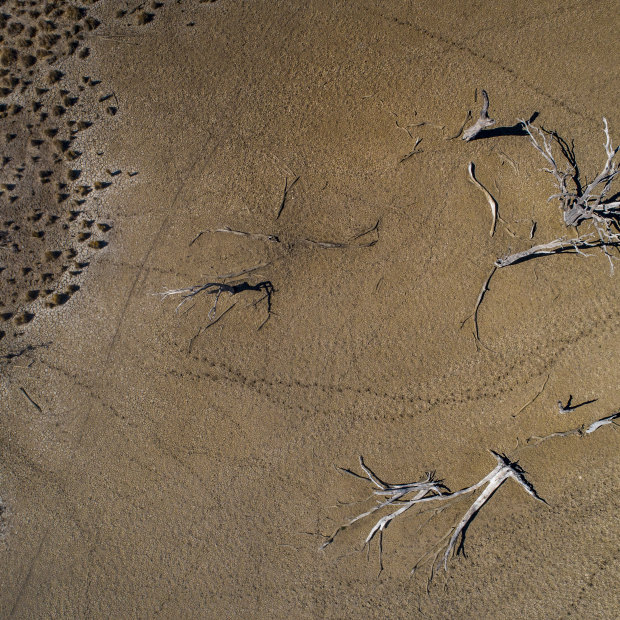
The town of Warren is a gateway to one of Australia's most important wetlands - the fast dessicating Macquarie Marshes.Credit: Wolter Peeters
If Rod Barclay or other firefighters get the call that a house is ablaze in the north-western NSW town of Warren, chances are they won't bother to put it out.
"Our priority is to save lives first, save water second," Barclay says on Thursday outside Warren's two-tanker fire station.
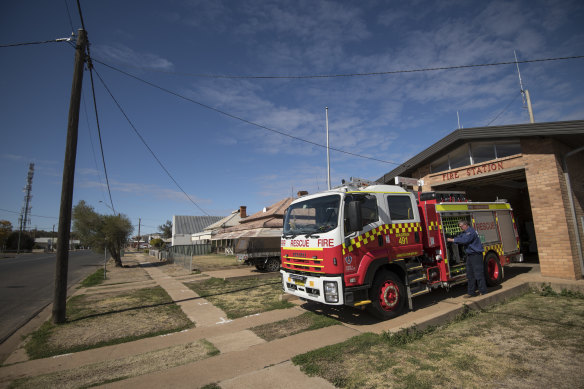
Rod Barclay tends to a NSW Fire & Rescue tanker at Warren's fire station.Credit: Wolter Peeters
Should one of the town's typical three-bedroom weatherboard homes ignite, Fire and Rescue NSW crews will only turn their hoses on the fire if they have to rescue anyone inside. Otherwise it will be sacrificed and water used merely to spray neighbouring homes if flames threaten to spread.
"Warren is the first location in which we're undertaking this new strategy," says Gary Barber, the Dubbo-based Fire & Rescue commander. "We could easily waste a couple of thousand litres on a house that's going to be lost," he says. "That water can certainly be used much better elsewhere in the community."
Warren, nestled beside the Macquarie River and midway between Brisbane and Melbourne, is at the epicentre of the worst drought to hit that region of inland NSW since European settlement.
Not only is the town a gateway to one of Australia's most important wetlands - the fast desiccating Macquarie Marshes - but it is also the last point to which the Macquarie River will flow for possibly many months. Last week, the NSW government ordered a lifting of the main weir at Warren to ensure communities fed by a diversion channel won't run out of water.
Peter Vlatko, the general manager of Cobar Shire Council, which covers towns almost totally dependent on that channel says conditions were now well past a worst-case scenario. "All of a sudden - holy shit!" he says. "Now it's out of the ballpark."
WaterNSW data supports that view. Inflows to the giant Burrendong Dam near Wellington - which regulates flows into the Macquarie - amounted to 99 gigalitres over the past two years, or just 6 per cent of the average.
Mayor of Warren Shire Milton Quigley says "it's not much in the public" that the town's fire crews won't squander water on a house that's going up.
On paper the town should be relatively well off, with abundant groundwater to compensate for the demise of river flows. That source, however, supplies the town with drinking water. Tapping it with fire pumps would run the risk of contamination and so is illegal, Quigley says as he stands near one of Warren's weirs. To aid in an emergency, a 45,000-litre tanker is parked in the shire's depot, in case the hospital, school or other major site catches fire.
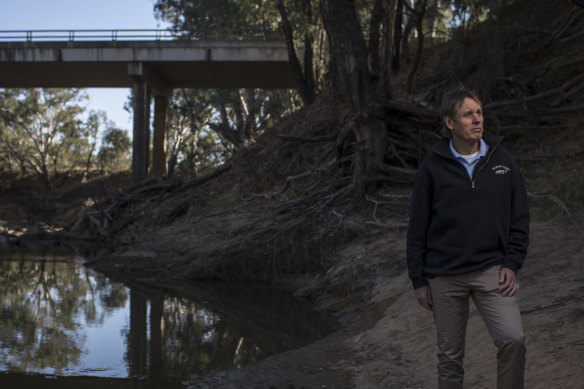
Milton Quigley, Mayor of Warren Shire Council, stands beside the Macquarie River, which ceased to flow beyond the town this week.Credit: Wolter Peeters
If the lack of river flows weren't bad enough, Warren's groundwater may not be guaranteed either. "The water table is going lower and it's becoming saltier," says the shire's general manager Glenn Wilcox. If the trend continues, he adds, "We'll never run dry but we'll be bathing in salt water."
The council was so concerned that it sent samples to NSW Health for testing. That agency told the The Sun-Herald and Sunday Age that sodium levels came in at 276 milligrams per litre, or slightly higher than the average since 2001. "The Australian Drinking Water Guidelines note that people may taste sodium in water above 180 mg/L," NSW Health said. "The guidelines also state that 'in major Australian reticulated supplies, sodium concentrations vary from 3 mg/L to 300 mg/L, with a typical value of 50 mg/L'."
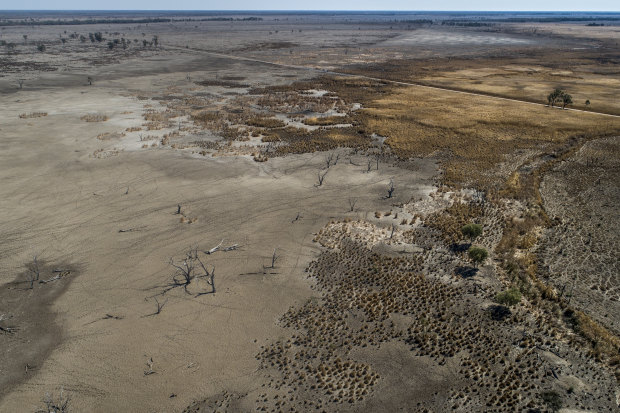
An aerial view of the southern Nature Reserve of the Macquarie Marshes. Credit: Wolter Peeters
Stuart Khan, a water expert at the University of NSW, notes those guidelines also warn that "medical practitioners treating people with severe hypertension or congestive heart failure should be aware if the sodium concentration in the patient’s drinking water exceeds 20 mg/L”.
Wilcox says water conductivity - another measure of quality - had also jumped four-fold or more. "It's definitely worth watching closely," Khan says. "Something must have changed, for sure."
One person to have witnessed huge change in Warren is 78-year-old George Riley, an elder of the Wayilwan people and chair of the Warren Macquarie Local Aboriginal Lands Council.
As a child, he swam and fished in the Ewanmar Creek near Warren. "It was like a supermarket," Riley says. Now the creek is bone dry despite being declared an "Aboriginal Place" by the state government in 2016.
Known as Beemunnel, the area had been a remarkable site for generations of Indigenous people, including for the first half of Riley's life. About 24 families, numbering more than 100 people, lived self-sufficiently in homes made from flattened kerosene tins and bark and whatever other materials they could gather.
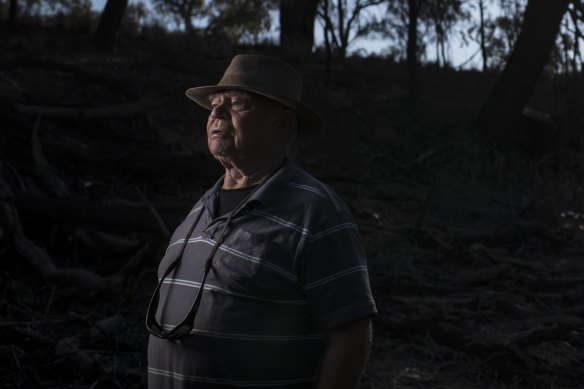
George Riley, chair of the Warren Macquarie Local Aboriginal Lands Council, stands in the Beemunnel Reserve where he swam and played as a child.Credit: Wolter Peeters
From about the 1950s, when government policy shifted to forced assimilation, local authorities pressured one family after another to leave. Each home was bulldozed when they did, their bora ground for initiation ceremonies dug up to provide earth for nearby road building, and a garbage dump deliberately plonked nearby.
With that history, Riley has no expectation Beemunnel will get access to river flows soon. "Irrigators, the town, the environment," Riley lists the priorities, all ahead of traditional owners' concern. "It's dead last, that's for sure."
'It's not the crop you plant, it's how much water you take'
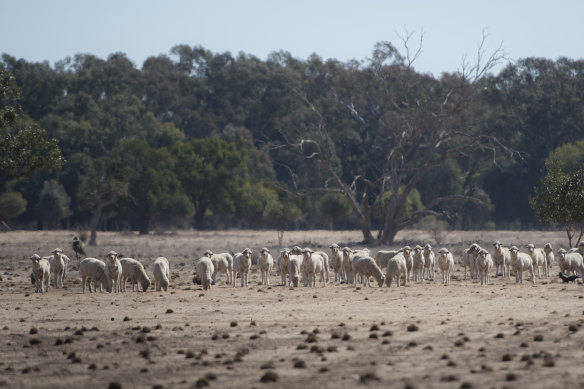
Sheep scratch around for remaining grass amid the dusty paddocks near Warren.Credit: Wolter Peeters
Irrigators are aware they have come in for much of the blame for excessive extraction from the Macquarie and other drying rivers in the Murray-Darling Basin. "There's been a lot of negativity about cotton," says chief of the National Irrigators' Council Steve Whan. "It's not the crop you plant, it's how much water you take."
He says the industry has had to take a large share of the reduction in water use, as part of the $13 billion Murray-Darling Basin Plan. He points to Australian Bureau of Statistics figures showing irrigators used 7800 gigalitres, not far shy of half the 13,000 GL take before the plan was put in place.
While many cotton and other farmers managed a crop near Warren last season, few will in the coming year. "It's looking pretty bad," he says. "It's just got worse and worse."
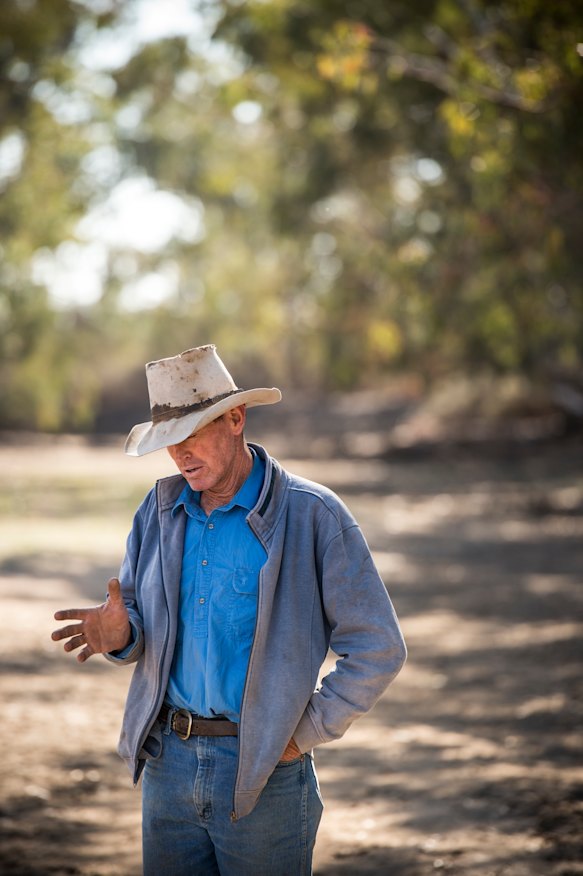
Angus Beef Cattle producer Garry Hall in a dry Macquarie River at his property in the Macquarie Marshes.Credit: Wolter Peeters
The industry is struggling to retain staff, which is made harder because nobody knows when the rains will return. The Bureau of Meteorology said this week it expects a drier than average end to the year, while temperatures for almost the whole country can be expected to be hotter than normal.
"All the critical town needs and the needs of the river come before the farmers," Whan says.
Drive north of Warren towards the Ramsar-listed Macquarie Marshes, though, and it's easy to see why a lot of rain will be needed to revive the land and its remaining native flora and fauna. The Ramsar Convention is an international agreement to protect wetlands, many of them hosting migratory birds, that are important to wildlife and broader ecosytem health. Australia has 66 such Ramsar sites.
"It's going to take floods and floods and floods - just to fill up the dams," says Mel Gray, a convenor of the Dubbo branch of environmental group Healthy Rivers as she points to a six-metre-high embankment built near the Marshes.
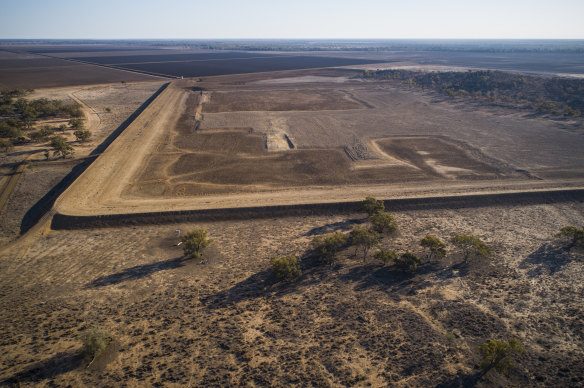
A huge water retention basin near Warren on the Macquarie River flood plain.Credit: Wolter Peeters
Gray says the irrigation industry likes to state that extraction only amounts to about 17 per cent of average flows, with the environment getting the rest, but in dry years that can rise to 60 per cent or more. For the 200,000-hectare Marshes, that has meant virtually no water reaching them this year, and little likelihood of fresh flow soon - especially now the weir is being raised at Warren.
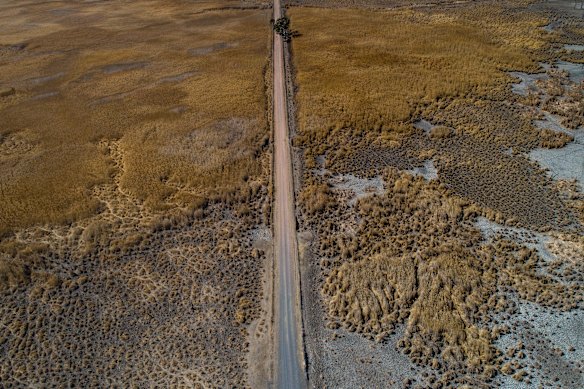
An aerial view of the Southern Macquarie Marshes Nature Reserve. Credit: Wolter Peeters
Richard Kingsford, a leading ecologist at the University of NSW, said the Marshes are one of the important waterbird hotspots in the Murray-Darling Basin, with a very high diversity of waterbirds, including many threatened species such as Australasian bittern and painted snipe.
"These wetlands have evolved to cope with dry times but the dry times are getting longer and more severe and consequently the wet times are less frequent, less extensive and don’t last as long," Kingsford says. "The last flood event when all the waterbirds were breeding on all the systems in the Macquarie Marshes was in 2000," he adds. "Large floods are critical for triggering magnificent breeding events of many species but they don’t happen as often or with so many species."
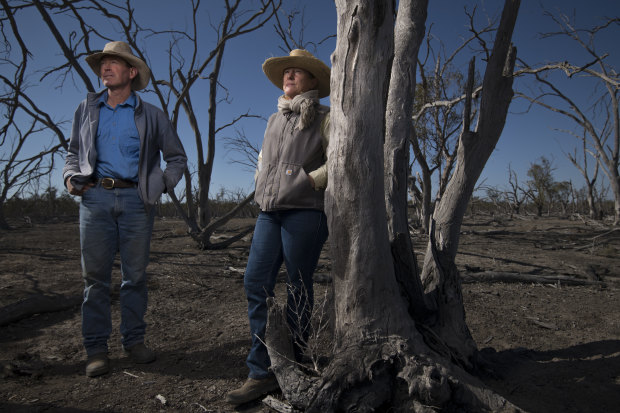
Garry and Leanne Hall, Angus beef cattle producers, on their land that includes part of the Macquarie Marshes.Credit: Wolter Peeters
When Leanne Hall first arrived at The Mole, a property sprawling more than 5500 hectares on the north-western edge of the Macquarie Marshes, the water was lapping to the levee bank as a slow-moving flood covered the land.
That was a quarter of a century ago. "There were hundreds of pelicans out there," Hall says as she looked out from her living-room window this week over a grassless plain. "When the water comes through, it just comes to life."
Those moments of flood clearly brought joy to the fourth-generation graziers. The family's photo collage on the wall is a celebration of the wet years when the Macquarie is in robust flow, bringing reed beds to life and drawing spoonbills, herons, egrets and ibises - among some 200 different species.
After a tour to a favourite family picnic spot on a short bend in the Macquarie River – now bone dry – the Halls take visitors to a patch of river red gums that are dead or dying, starved of over-bank flows.
The Mole has all but destocked, down from 720-odd Angus cattle to just 20, and there’s not been a forage crop to feed them for two years.
The toll is more than financial. Gone are those family gatherings by the Macquarie River, which Garry Hall equates to living in Sydney with a view of the harbour. “This is a big deal,” he says, pausing between each word, as he stands with his wife among the lifeless trunks.
“The change I see for me and the Marshes is that we’re going to have to wait so much longer after this drought than ever before to begin our recovery,” he says.
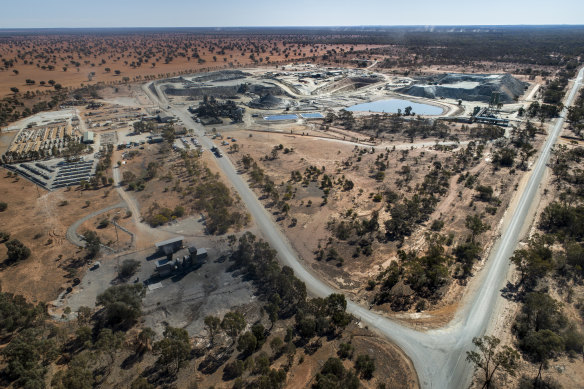
The Aeris Tritton Copper Mine is one of several drawing water from the Macquarie River diverted at Warren. Credit: Wolter Peeters
If farmers are doing it tough, miners dependent on dwindling flows may not be far behind. North-west towards Cobar, a string of gold, copper and other mines need the water being diverted at Warren because groundwater reserves are few and far between.
Vlatko, the Cobar shire's general manager, says that with Burrendong Dam at 4.6 per cent full and falling, the town has been told the Macquarie will cease natural flows as soon as November. Pumps to extract "dead water" below current release levels could extend that to next May.
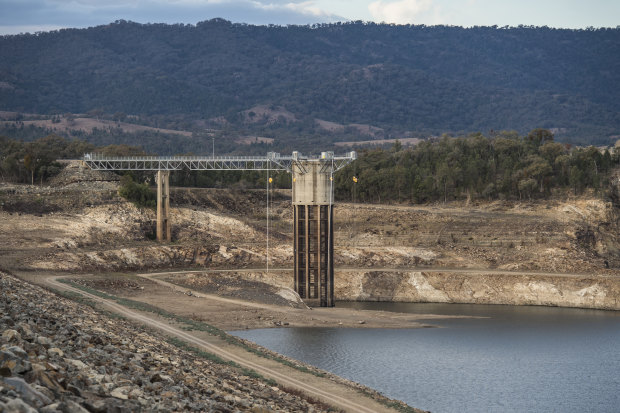
Burrendong Dam as it sank to just 4.6 per cent full in late August, 2019. Without good rains and efforts to pump so-called 'dead water', flows on the Macquarie River could cease by November.Credit: Wolter Peeters
Some small towns such as Hermidale are already trucking in water and others such as Nymagee might not be far behind, Vlatko says.
Cobar has cut daily water use by one-third to 2 million litres a day and that tally will likely double as summer approaches and residents turn on their evaporative coolers to fend off the days, if not weeks, of 40-degree heat.
Without relieving rains, "one day the mines will have to stop working because they don't have any water," he says. "The domino effect [on the town] would be huge."
A last resort "and very expensive one" would be to bring in water by train, but even that option could barely supply a quarter of the town's needs alone. "We won't be drinking tea, we'll be drinking beer," he jokes.
More seriously, Vlatko says it wouldn't just be Cobar in trouble if there's no water. "For us to run out of water - it's unthinkable," he says. "But it's not only us, it's the whole state."